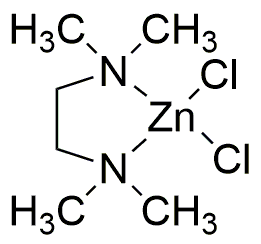Dichloro(N,N,N',N'-tetramethylethylenediamine)zinc(II) is widely utilized in research focused on:
- Catalysis: This compound serves as an effective catalyst in various organic reactions, enhancing reaction rates and selectivity, particularly in the synthesis of complex organic molecules.
- Coordination Chemistry: It is used in the study of coordination compounds, helping researchers understand metal-ligand interactions, which are crucial in fields like materials science and bioinorganic chemistry.
- Organic Synthesis: The compound plays a significant role in organic synthesis, particularly in the preparation of pharmaceuticals and agrochemicals, due to its ability to stabilize reactive intermediates.
- Electrochemistry: It is applied in electrochemical studies, where it can help improve the efficiency of electrochemical cells and batteries, contributing to advancements in energy storage technologies.
- Nanotechnology: This chemical is utilized in the synthesis of metal nanoparticles, which have applications in catalysis, drug delivery, and imaging, showcasing its versatility in modern research.
General Information
Properties
Safety and Regulations
Applications
Dichloro(N,N,N',N'-tetramethylethylenediamine)zinc(II) is widely utilized in research focused on:
- Catalysis: This compound serves as an effective catalyst in various organic reactions, enhancing reaction rates and selectivity, particularly in the synthesis of complex organic molecules.
- Coordination Chemistry: It is used in the study of coordination compounds, helping researchers understand metal-ligand interactions, which are crucial in fields like materials science and bioinorganic chemistry.
- Organic Synthesis: The compound plays a significant role in organic synthesis, particularly in the preparation of pharmaceuticals and agrochemicals, due to its ability to stabilize reactive intermediates.
- Electrochemistry: It is applied in electrochemical studies, where it can help improve the efficiency of electrochemical cells and batteries, contributing to advancements in energy storage technologies.
- Nanotechnology: This chemical is utilized in the synthesis of metal nanoparticles, which have applications in catalysis, drug delivery, and imaging, showcasing its versatility in modern research.
Documents
Safety Data Sheets (SDS)
The SDS provides comprehensive safety information on handling, storage, and disposal of the product.
Product Specification (PS)
The PS provides a comprehensive breakdown of the product’s properties, including chemical composition, physical state, purity, and storage requirements. It also details acceptable quality ranges and the product's intended applications.
Certificates of Analysis (COA)
Search for Certificates of Analysis (COA) by entering the products Lot Number. Lot and Batch Numbers can be found on a product’s label following the words ‘Lot’ or ‘Batch’.
*Catalog Number
*Lot Number
Certificates Of Origin (COO)
This COO confirms the country where the product was manufactured, and also details the materials and components used in it and whether it is derived from natural, synthetic, or other specific sources. This certificate may be required for customs, trade, and regulatory compliance.
*Catalog Number
*Lot Number
Safety Data Sheets (SDS)
The SDS provides comprehensive safety information on handling, storage, and disposal of the product.
DownloadProduct Specification (PS)
The PS provides a comprehensive breakdown of the product’s properties, including chemical composition, physical state, purity, and storage requirements. It also details acceptable quality ranges and the product's intended applications.
DownloadCertificates of Analysis (COA)
Search for Certificates of Analysis (COA) by entering the products Lot Number. Lot and Batch Numbers can be found on a product’s label following the words ‘Lot’ or ‘Batch’.
*Catalog Number
*Lot Number
Certificates Of Origin (COO)
This COO confirms the country where the product was manufactured, and also details the materials and components used in it and whether it is derived from natural, synthetic, or other specific sources. This certificate may be required for customs, trade, and regulatory compliance.


